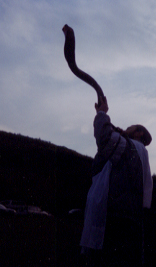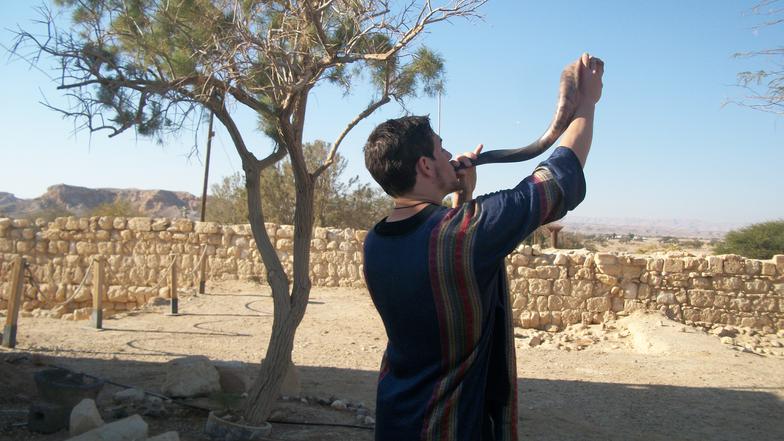Yom T'ruah
The Day of the Awakening Blast
Yom Truah ("yoam TRUE-ah") is the first day of the seventh month, after a long season--nearly four months--with no prescribed festivals.
There are very few Biblical commands about this holy day. We are only told to gather and blow trumpets or shofars. (Lev. 23:24) On it we are to do no servile labor, and are to bring particular offerings. (Num. 29:1ff) No reason is even given for this holiday. The word truah, though, tells us more. It has many shades of meaning. It can mean, "a blast or blowing of a trumpet", "an alarm" (Ezekiel 33:3-6), "a battle-cry" (Judges 3:27, II Samuel 20:1), or "a shout of joy". So we must see it from each of these angles. Some say the command is actually to HEAR (shema') the shofar being blown, not necessarily to blow it yourself.
This is not one of the pilgrimage festivals, so it was not just in Jerusalem, but in the whole Land of Israel, that one would be able to hear shouts and shofar blasts. Since this is only a few days before the Feast of Booths (Sukkoth), which is one of the pilgrimage feasts, YHWH says that if we are keeping YHWH's commands and pleasing Him, He will not even let any of our enemies want to steal our possessions, and this may help keep them at bay.
Tradition says that on this date, Adam was created, the flood of Noach dried up, Enoch (Hanokh) was taken to be with YHWH, Sarah, Rakhel, and Shmu'el were conceived, and we know that on this day Ezra read the Torah to the returnees from exile (Neh. 8:2). The resurrection of the dead will occur on this day, according to tradition (based on Yeshayahu 18:3, which says those who "dwell/remain in the earth" (i.e., the dead) will see a sign on the mountain and hear a trumpet when it sounds. (Compare Yochanan 5:25.)
Other themes of this day:
Alerting us to the fact that Yom Kippur is near to make sure we are ready
The summons of the living back to the Land may thus occur on this day as well
Coronation of the King (1 Kgs. 1:34, 39)
Repentance
Judgment
Creation
Other names for Yom Truah:
In modern Judaism, Yom Truah is nearly always called Rosh haShanah ("roash ha-sha-NAH", meaning "Head of the Year"), but it refers to the creation year or the civil calendar rather than the calendar YHWH gave to Israel in particular after the Exodus. It is the anniversary of creation--traditionally the sixth day of creation, to be exact (the day Adam was created).
The Last Trump: an idiom for Yom Truah. This is what is alluded to in 1 Corinthians 15:52, and it confirms that this is the context for the resurrection. Though it is called the "last", it is actually the second of three important shofars: the first was heard on Shavuot at Mount Sinai (Ex. 19:18-19); this one is the second; and the Great Trump is one heard on Yom Kippur. (See Y'shua's allusion to this in Mat. 24:29-31.) The first two are considered to correlate with the two horns of the ram caught in the thicket (Gen. 22). (Compare 1 Thess. 4:16-17.)
Yom haKeseh: "The hidden day": When Y'shua said, "No man knows the hour or the day", he was referring to this idiom, because this is the one major festival that is on the new moon, so we will not know whether it will be this day or the next until it is right upon us. Of course we can anticipate its nearness by watching the signs in the heavens. This is also the only commanded feast that since ancient times was celebrated for two days (though only one is prescribed) because it could take the eyewitnesses or heralds some time to reach all parts of the country with the news of the sighting.
Yom haZikkaron or Zikkaron Truah ("Day of Remembrance/Shouting of remembrance")
Yom haDin: The first of two "days of judgment", the second being nine days later on Yom haKippurim. On Yom Truah, the Talmud says, it is determined who will be inscribed in the Book of Life for that year, and who in the Book of Death, and it is sealed on Yom Kippur. The intervening period is called the "Days of Awe" (Yamim Noraim)--the most solemn time of the whole year, with the focus being on repentance in the most intense way. It follows the month of Elul, which is an acronym for Ani l'dodi w'dodi li: "I belong to my beloved and my beloved belongs to me." (Song of Solomon 6:3--a royal There are thus forty days in this special season of T'shuvah (repentance and return). It is said that during this time the King is in the field rather than in the palace, so that he can be more accessible even to the peasants. There are no doors or walls between Him and us at this time, so we need to take advantage of this special invitation to draw closer. One cannot fully enter into the joy of Sukkoth without this step.
It is Jewish Tradition to eat apples and honey, and/or round challah (a symbol of perfection) dipped in honey. Some make challah in the shape of a ladder to recall Yaaqov's dream when he slept on what would later become the Temple Mount. It is traditional to bake a whole fish, head, tail, and all, and eat from near the head to symbolize that this year you will be the "head, not the tail" ; others eat the head of a lamb. Another custom is to eat new fruit of a type you have not yet eaten this season. Other sweet foods like teiglach (crunchy dough boiled in honey) or tzimmes (honey-baked carrots) are eaten. The reason for the latter is that the Yiddish word meren means both "carrots" and "increase". Many Jews practice tashlikh, a custom of throwing pieces of bread into a river so that it flows away to the sea, based on Mikha 7:19. Many wear white (a symbol of purity) and even dress the Torah scroll in white. The shofar is blown 100 times throughout the day, using three distinct sounds: the tekiah (one long, mellow note), shevarim (a series of three medium blasts), and, of course, the truah (anywhere from eight to twelve staccato blasts followed by one long blast).
Some additional traditions include a large meal together, shofar-blowing contests, and making our own shofars (in advance) from untreated animal horns.
A 21st-century shofar!
What's All the Shouting About?
(Num. 10:1-10; Neh. 8:1-12; Psalms 47, 98, 100: Jer. 31)
There are very few actual commands regarding this day (Leviticus 23:23-25; Numbers 29:1-6)—no servile work, some trumpeting or shouting, and special animal offerings. It is overtly a reminder (though it does not say of what, but probably that Yom haKippurim is right around the corner and we need to repent and get ready). The noise can’t help but get our attention. It’s meant to jar us fully awake like an alarm clock.
Besides an alarm, ruah, the root word for the name of this day, can mean anything from shouting to blowing trumpets or ram’s horns (shofaroth) to a signal or even a battle cry. But “if the trumpet gives an indistinct sound, who will prepare for battle?” (1 Cor. 14:8) This is an allusion to Numbers chapter 10, where different types of trumpeting signal codes are defined. One of them is to call an assembly, and there is indeed a holy “calling forth” to an assembly or convocation (Num. 29:1), which can also mean a “rehearsal”, hinting that it is a precursor or forerunner of something yet to come which involves the whole people of Israel being “called out”. Those things are all the Torah’s terms require. Anything else is just tradition, conjecture, or deduction based on other scriptures which we will look at.
Psalm 100 uses this same word ruah to call “all the earth” to shout to YHWH, hinting that ultimately it is for more than just Israel, though they are still called “His people” here. Psalm 47 (written by Qorakh’s descendants, interestingly!) similarly connects the shouting and shofar blasts to YHWH triumphing over the nations, being enthroned, and reigning over all nations. Could that begin this Yom T’ruah?
Nowhere in Scripture is it called the new year, though Sukkoth, which follows close on its heels, is called “the feast of ingathering as the year goes out” (Ex. 23:16) or “the year’s turning (completion of a circuit)” (Ex. 34:22). Thus it is a transitional time: the harvest is completed, so a new growing season begins. But Yom T’ruah is always called the first day of the 7th month. It was once the first month (Exodus 12:2), so the idea that it is the month of creation is probably accurate. But it is not the Jewish new year, for YHWH said that for Israel, what used to the 7th month (Aviv) is now the first. He did not change it for anyone else, so for secular matters (like a fiscal year) or for other nations, it may be new year--but not for Israel.
When Ezra read the Torah in Jerusalem after the 70-year exile was over (Nehemiah 8), it was on this date. Imagine hearing it read for the first time in 70 years! Many of the returnees from exile no longer spoke Hebrew, only Aramaic, and it had to be translated for them. (8:8) Might the Misha’el who joined Ezra (8:4) have been Daniel’s friend by the same name—one of the three who survived the fiery furnace? Might he have been among those who made it back to the land? Other words for joyful shouting describe the time the rest of Israel besides Judah will come back. (Jer. 31:5-6).
There is no mention of the shofar in Nehemiah 8, but they did notice the command about Sukkoth--only two weeks away, but enough time to get ready and obey the command rightly. (8:14) We do learn here that though the people were grieved at their failure to have kept up obedience to YHWH’s instructions, we are not supposed to be sad on this holy day, but joyful. (8:9-12) So though it is solemn and sobering, reminding us that Yom Kippur (the day of atonement but of judgment first) is just ahead, it is meant to be full of hope at what YHWH can do to rectify the things that have gotten out of kilter in our lives.
Yom T’ruah itself initiates the season of judgment. Psalm 98 links the trumpeting and shouting and singing a new song to YHWH with His coming to judge the earth, with all the nations looking on and seeing His righteousness and His deliverance, which is part of His faithfulness to Israel. Many therefore see a connection between this day and the initiation of the trumpet signaling the final judgment of this age and the beginning of the Messianic kingdom. That is a great reason to shout!





